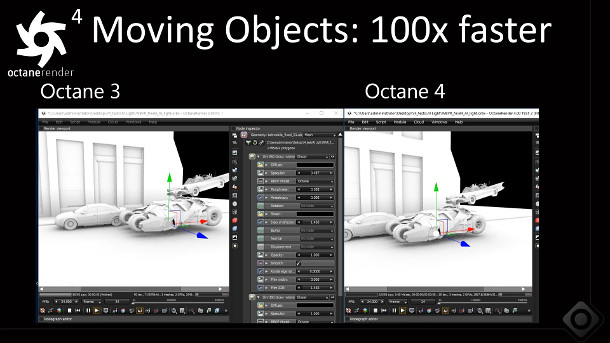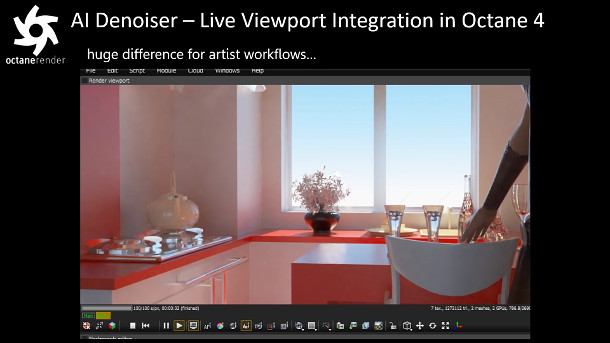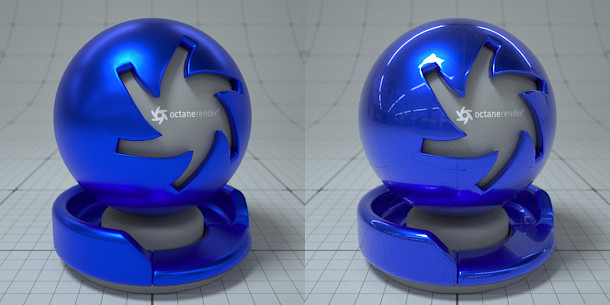Otoy ships OctaneRender 4.0
Originally posted on 20 March 2018. Scroll down for news of the final release.
Otoy has released OctaneRender 4.0, the long-awaited update to its GPU production renderer, as a free public preview for existing uers.
The release integrates Brigade, Otoy’s real-time path tracing engine, into OctaneRender, speeds up scene updates by up to 100x, and introduces intriguing new AI-based lighting and denoising systems.
Otoy has also announced that the software will be free to use on two GPUs, including access to 12 of the company’s integration plugins for DCC applications.
Two years since the original announcement
First announced in April 2016, OctaneRender 4.0 was originally supposed to ship last year, although the original roadmap has slipped considerably since then: the current stable release is still OctaneRender 3.08.
Although it’s still an experimental preview, today’s release shows that development work on version 4.0’s original key features is advancing – and throws in some exciting new features of its own.

Integration of the Brigade engine, major speed boosts to scene loading and updating
First up, the major feature we already knew about: version 4.0 integrates Brigade, Otoy’s real-time path tracing engine – itself a work in progress for over five years – into OctaneRender.
The integration, which gives OctaneRender a new “game-engine-like scene graph”, promises considerable speed boosts.
Otoy claims that scenes load up to 10x faster than in version 3.x, and update up to 100x faster – a “night and day difference” that makes it possible to scrub through FBX and Alembic animations in real time.
AI Scene juggles scene geometry between GPU and out-of-core memory
There is also a new system for handling out-of-core geometry, making it possible to render scenes too large to fit into available GPU memory without the speed hit usually associated with the process.
The demo video above shows a “worst case scenario” of a 40GB scene being handled entirely as out-of-core geometry, with the scene still maintaining a steady frame rate of 60fps.
The division of scene assets between in-core and out-of-core memory is handled by the first of the new AI-based technologies that Otoy has just announced: the AI Scene system.
According to Otoy, the system models the visibility of surfaces within the scene on a per-view basis to maintain optimum performance for out-of-core-geometry.
New AI-based light sampling and spectral denoising systems
The second AI-based technology, AI Light, improves sampling, particularly in scenes with many point lights.
As a machine learning system, its performance “improves as you render more samples”, and it can be used in conjunction with OctaneRender’s existing Adaptive Sampling system.
According to Otoy, it makes a “big (6-10x) difference in multi-point/spot light scenes” – presumably in the time taken to resolve the render to an acceptably low noise level.
Unlike Nvidia’s AI-based OptiX 5.0 denoising system, recently integrated into V-Ray Next, it isn’t a post process, but is calculated in real time during the render itself.

However, OctaneRender 4.0 does introduce its own spectral AI-based denoising system, described as highly complementary to AI Light.
AI Denoiser works from “internal perceptual models of material, spectral irradiance and scene data … before [conversion] to RGB in the viewport”.
The preview build includes dedicated denoisers for glass and refractive materials, with further denoisers for volumetrics, subsurface scattering materials, hair and the viewport planned for future builds.
New features planned for future builds
Other new features planned between the current preview build and the final release include a rounded edge shader, and random walk subsurface scattering. Both are due to roll out in OctaneRender 3.09.
There will also be a new Open Shading Language-based AOV mixer, and deep pixel, multi-view and light field rendering will be “improved”.
Otoy also plans to introduce a new ubermaterial – “eventually a universal layered material” – presumably along the lines of the principled Disney shaders found in many other renderers.
Free to use on up to two GPUs: subscribers now get up to 20 GPUs
The release will also change Otoy’s pricing model, making OctaneRender 4.0 free to use on 2 GPUs, including for commercial jobs.
The free edition will contain all of the features from the paid editions, and will provide access to around 12 of the integration plugins for common DCC and CAD tools, with “more coming”.
OctaneRender subscriptions will also be expanded: instead of getting access to a single integration running on up to two GPUs, users will get all of the plugins, support for up to 20 40 GPUs, and a second slave licence.
Subscription pricing remains unchanged at $20/month, with extra render nodes available for $10/month.
The current perpetual licences of the software will be transitioned into an “enterprise tier” with support for up to 200 networked GPUs, and Nvidia’s NVLink GPU interconnection technology.
We don’t have any information on enterprise pricing yet, but we’ll update if it becomes available.

Updated 14 August 2018: Otoy has released the first release candidate build of OctaneRender 4.0 at the Siggraph 2018 conference, meaning that the software is now feature-locked.
Since the original preview, the firm has released a steady stream of updates to the software: initially just bugfixes, but more recently, adding some significant new features.
The ubermaterial (above) has been added, and supports light transmission, dispersion, thin film interference, and emission – among other things, making it possible to recreate coated materials like car paint.
The OctaneRender 4.0 XB4 update, released late last month, added support for light linking and universal light exclusion, enabling users to control which lights in a scene illuminate individual surfaces.
The release also introduced support for the UDIM UV space used in tools like Mari.
New in RC1: AI-based volume denoising, GPU texture compression
To that, the new RC 1 build adds a second AI denoising system specifically trained to denoise volumes and volume passes; and the option to import individual layers from multi-layer EXR files.
The update also introduces texture compression when rendering: according to Otoy, compressed textures occupy as little as 1/8 of the VRAM required for uncompressed files and are “often visually identical”.
There are also several performance improvements: notably, Otoy claims that OBJ loading is 15-25% faster.
Updated 22 November: Otoy has officially released OctaneRender 4.0 after a series of seven release candidate builds. You can see the online changelog here.
The company has also raised the number of GPUs supported in the OctaneRender Studio subscription edition from 20 to 40.
Availability and release dates
OctaneRender 4.0 is available for Windows 7+, Linux and macOS 10.12+. It’s CUDA-based, so you’ll need a suitable Nvidia graphics card. You can find more details of the system requirements here.
A new standalone Enterprise licence costs $399; integration plugins for DCC applications cost $139 to $269 each. Bundle deals and ‘All Access’ subscriptions for the plugins are also available.
The update is free to registered users of OctaneRender 3.x.
Updated: The free two-GPU edition is due for release in “Q1 2019”, though Otoy has said that it “may need to rethink” the two-GPU limit for the upcoming OctaneRender 2018.1. See its FAQs here.
